Death and the Maiden (motif)
Death and the Maiden (Der Tod und das Mädchen in German) was a common motif in Renaissance art, especially painting and prints in Germany. The usual form shows just two figures, with a young woman being seized by a personification of Death, often shown as a skeleton. Variants may include other figures. It developed from the Danse Macabre with an added erotic subtext. The German artist Hans Baldung depicted it several times.[1]

The motif was revived during the romantic era in the arts, a notable example being Franz Schubert's song "Der Tod und das Mädchen", setting a poem by the German poet Matthias Claudius. Part of the piano part was re-used in Schubert's famous String Quartet No. 14, which is therefore also known by this title, in either English or German.[1]
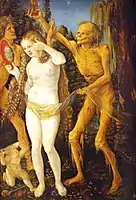 Hans Baldung Grien, 1509–11, Vienna
Hans Baldung Grien, 1509–11, Vienna Hans Burgkmair, Lovers Surprised by Death, 1510
Hans Burgkmair, Lovers Surprised by Death, 1510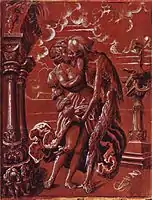
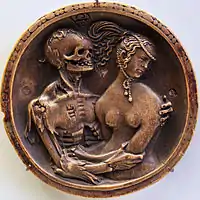 Boxwood carving by Hans Schwarz, c. 1520
Boxwood carving by Hans Schwarz, c. 1520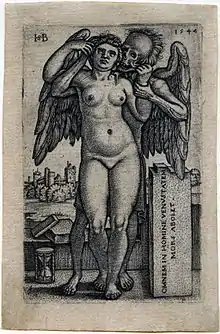 Small engraving by Barthel Beham, 1547
Small engraving by Barthel Beham, 1547 La jeune fille et la mort by Henri-Léopold Lévy, 1900
La jeune fille et la mort by Henri-Léopold Lévy, 1900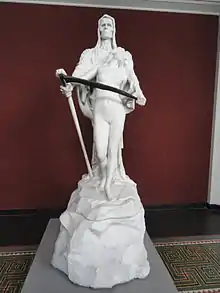
 Heinrich Hoerle, c. 1919
Heinrich Hoerle, c. 1919
Selected versions
- Painting: Death and the Maiden (Der Tod und das Mädchen) by Niklaus Manuel Deutsch I (1517)
- Painting: Death and the Maiden (Der Tod und das Mädchen) by Hans Baldung Grien (1517)
- Engraving: Death and the Maiden (Døden og Piken) by Edvard Munch (1894)
- Painting: Death and the Maiden (Der Tod und das Mädchen) by Adolf Hering (1900) - the painting is part of a private collection, the location is unknown.
- Painting: Death and the Maiden by Marianne Stokes (1900)
- Painting: Death and the Maiden (Der Tod und das Mädchen) by Egon Schiele (1915)
- Drawing: Death and the Maiden (Der Tod und das Mädchen) by Clara Siewert (1920s)
- Drawing: Death and the Maiden (Der Tod und das Mädchen) by Joseph Beuys (1959)
Notes
- Le Mort dans l'Art
References
![]() Media related to Death and the maiden at Wikimedia Commons
Media related to Death and the maiden at Wikimedia Commons
- Death and the Maiden @ La Mort dans l'Art